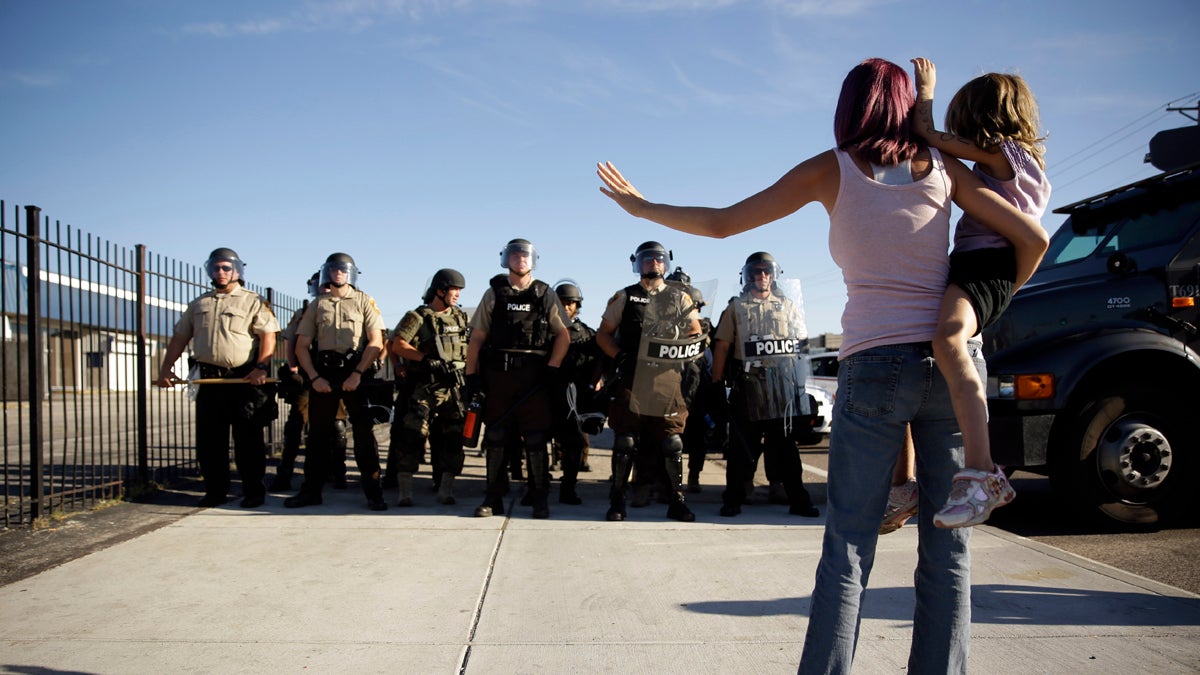Rand Paul is right about racial injustice and militarized cops

Protester Janelle Pittman holds her 6-year-old daughter, Kat, as police in riot gear stand guard in Ferguson, Mo. on Wednesday, Aug. 13, 2014. On Saturday, Aug. 9, 2014, a white police officer fatally shot Michael Brown, an unarmed black teenager, in the St. Louis suburb. (Jeff Roberson/AP Photo)
Like a stopped clock twice a day, Rand Paul occasionally gets it right. So let’s give him props for speaking out yesterday against the militarization of local cops.
He also deserves credit for trying to change the longstanding Republican “law and order” paradigm. Ever since Nixon in ’68, the standard GOP impulse has been to support the police on the streets. But Paul, eyeing the White House and realizing that his nearly all-white party can’t win nationally unless it racially diversifies, has rightly seized on the Ferguson, Missouri story. This is not naked opportunist; rather, this is one of those instances where smart policy is good politics.
Unlike virtually all his Republican colleagues, Paul is outraged that a small-town cop would fatally shoot an unarmed black teenager who had the temerity to walk in the street instead of on the sidewalk. (The town is 65 percent black; the police force is 91 percent white.) And Paul seems to instinctively grasp the key racial issue. As he wrote yesterday in a Time magazine column:
If I had been told to get out of the street as a teenager, there would have been a distinct possibility that I might have smarted off. But I wouldn’t have expected to be shot….Given the racial disparities in our criminal justice system, it is impossible for African-Americans not to feel like their government is particularly targeting them…It is what the citizens of Ferguson feel when there is an unfortunate and heartbreaking shooting like the incident with Michael Brown. Anyone who thinks that race does not still, even if advertently, skew the application of criminal justice in this country is just not paying close enough attention.
And his second concern – about the increasing militarization of local police, who for years have amassed oodles of war toys on the federal dime – is inextricably intertwined with his first. A majority black community can’t help but feel alienated from their town’s white power structure when the cops hit the streets outfitted as if they were jonesing to fight ISIS.
Paul quoted an ally at the libertarian Cato Institute, who asked this week, “Why armored vehicles in a Midwestern inner suburb? Why would cops wear camouflage gear against a terrain patterned by convenience stores and beauty parlors?” And this isn’t just about Ferguson. Citing a few random examples, why would the cops in Bossier Parish, Louisiana need a .50-caliber gun mounted in an armored vehicle? Who would the cops in Willimantic, Connecticut need a Mine Resistant Ambush Protected tank, built to withstand armor-piercing roadside bombs?
Simple answer: because the stuff is available.
The Ferguson cop overkill has spotlighted a national issue that has been simmering below the surface for years, with scant public debate. Thanks to a ’97 federal law, the Pentagon (blessed with its bloated contracts) has been free to donate its excess military gear to local police departments everywhere. And things only got worse after 9/11; in the name of “anti-terrorism,” the Department of Homeland Security has reportedly spent $34 billion to give local cops everything from drones to tanks. As a result, the police have become paramilitaries, free to employ their war toys as they see fit.
From a news story today: “In most instances, the government did not require training for police departments receiving military-style equipment and few if any limitations were put on its use…The increase in military-style equipment has coincided with a significant rise in the number of police SWAT teams, which are increasingly being used for routine duties such as conducting liquor inspections and serving warrants.”
Rand Paul, of course, is hardly the first to spot this trend. In a June report, the ACLU detailed the dangers: “The militarization of American policing is evident in the training that police officers received, which encourages them to adopt a ‘warrior’ mentality and think of the people they are supposed to serve as enemies” – especially, as evidenced by the statistics, when the people are “people of color.”
Moreover, the ACLU rightly noted, “The militarization of policing in the United States has occurred with almost no public oversight.” No surprise there; politicians typically woo the cops, and covet cop group endorsements. So let’s put our hands together for Georgia congressman Hank Johnson, who’s floating a bill to curb federal weapon donations; as he said yesterday, “it behooves us to reign in the Pentagon’s 1033 program and revisit the merits of a militarized America.”
And all the more reason to credit Rand Paul for at least daring to say (unlike most Republicans) that local cops shouldn’t disproportionately harass minorities and arm themselves to the teeth like “small armies.”
Granted, Paul is trying to fold the militarization issue into his overall critique about the inherent evils of “big government,” and I question whether he can successfully woo minority voters – who tend to benefit from federal civil rights laws and safety nets. But any time a politician shows a willingness to think outside the box – and, in his case, breach Republican orthodoxy – then it’s a good day.
Follow me on Twitter, @dickpolman1, and on Facebook.
WHYY is your source for fact-based, in-depth journalism and information. As a nonprofit organization, we rely on financial support from readers like you. Please give today.

